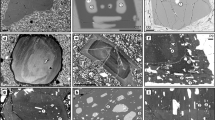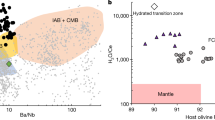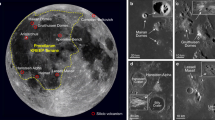Abstract
Cratons, the ancient cores of continents, contain the oldest crust and mantle on the Earth (>2 Gyr old)1. They extend laterally for hundreds of kilometres, and are underlain to depths of 180–250 km by mantle roots that are chemically and physically distinct from the surrounding mantle2,3,4. Forming the thickest lithosphere on our planet, they act as rigid keels isolated from the flowing asthenosphere5; however, it has remained an open question how these large portions of the mantle can stay isolated for so long from mantle convection. Key physical properties thought to contribute to this longevity include chemical buoyancy due to high degrees of melt-depletion and the stiffness imparted by the low temperatures of a conductive thermal gradient2,6,7. Geodynamic calculations, however, suggest that these characteristics are not sufficient to prevent the lithospheric mantle from being entrained during mantle convection over billions of years6,7. Differences in water content are a potential source of additional viscosity contrast between cratonic roots and ambient mantle owing to the well-established hydrolytic weakening effect in olivine8,9,10, the most abundant mineral of the upper mantle. However, the water contents of cratonic mantle roots have to date been poorly constrained. Here we show that olivine in peridotite xenoliths from the lithosphere–asthenosphere boundary region of the Kaapvaal craton mantle root are water-poor and provide sufficient viscosity contrast with underlying asthenosphere to satisfy the stability criteria required by geodynamic calculations9. Our results provide a solution to a puzzling mystery of plate tectonics, namely why the oldest continents, in contrast to short-lived oceanic plates, have resisted recycling into the interior of our tectonically dynamic planet.
This is a preview of subscription content, access via your institution
Access options
Subscribe to this journal
Receive 51 print issues and online access
$199.00 per year
only $3.90 per issue
Buy this article
- Purchase on Springer Link
- Instant access to full article PDF
Prices may be subject to local taxes which are calculated during checkout



Similar content being viewed by others
References
Walker, R. J., Carlson, R. W., Shirey, S. B. & Boyd, F. R. Os, Sr, Nd, and Pb isotope systematics of southern African peridotite xenoliths: implications for the chemical evolution of subcontinental mantle. Geochim. Cosmochim. Acta 53, 1583–1595 (1989)
Jordan, T. H. Composition and development of the continental tectosphere. Nature 274, 544–548 (1978)
Larson, A. M., Snoke, J. A. & James, D. E. S-wave velocity structure, mantle xenoliths and the upper mantle beneath the Kaapvaal craton. Geophys. J. Int. 167, 171–186 (2006)
Muller, M. R. et al. Lithospheric structure, evolution and diamond prospectivity of the Rehoboth Terrane and western Kaapvaal craton, southern Africa: constraints from broadband magnetotellurics. Lithos 112 (S1). 93–105 (2009)
James, D. E., Fouch, M. J., VanDecar, J. C. & van der Lee, S. Tectospheric structure beneath Southern Africa. Geophys. Res. Lett. 28, 2485–2488 (2001)
O'Neill, C. J., Lenardic, A., Griffin, W. L. & O'Reilly, S. Y. Dynamics of cratons in an evolving mantle. Lithos 102, 12–24 (2008)
Sleep, N. H. Survival of Archean cratonal lithosphere. J. Geophys. Res. B 108, 2302–2331 (2003)
Mackwell, S. J., Kohlstedt, D. L. & Paterson, M. S. The role of water in the deformation of olivine single crystals. J. Geophys. Res. 90, 11319–11333 (1985)
Hirth, G., Evans, R. L. & Chave, A. D. Comparison of continental and oceanic mantle electrical conductivity: is the Archean lithosphere dry? Geochem. Geophys. Geosyst. 1, 2000GC000048 (2000)
Li, Z.-X. A. et al. Water contents in mantle xenoliths from the Colorado Plateau and vicinity: implications for the mantle rheology and hydration-induced thinning of continental lithosphere. J. Geophys. Res. B 113, 1–22 (2008)
Bell, D. R. & Rossman, G. R. Water in Earth's mantle: the role of nominally anhydrous minerals. Science 255, 1391–1397 (1992)
Woodland, A. B. & Koch, M. Variation in oxygen fugacity with depth in the upper mantle beneath the Kaapvaal craton, Southern Africa. Earth Planet. Sci. Lett. 214, 295–310 (2003)
Lazarov, M., Woodland, A. B. & Brey, G. P. Thermal state and redox conditions of the Kaapvaal mantle: a study of xenoliths from Finsch mine, South Africa. Lithos 112 (S2). 913–923 (2009)
Bell, D. R., Schmitz, M. D. & Janney, P. E. Mesozoic thermal evolution of the southern African mantle lithosphere. Lithos 71, 273–287 (2003)
James, D. et al. Xenolith constraints on seismic velocities in the upper mantle beneath southern Africa. Geochem. Geophys. Geosyst. 5, Q01002 (2004)
Gurney, J. J. & Harte, B. Chemical variations in upper mantle nodules from southern African kimberlites. Phil. Trans. R. Soc. Lond. A 297, 273–293 (1980)
Peslier, A. H., Woodland, A. B. & Wolff, J. A. Fast kimberlite ascent rates estimated from hydrogen diffusion profiles in xenolithic olivines from Southern Africa. Geochim. Cosmochim. Acta 72, 2711–2722 (2008)
Dixon, J. E., Dixon, T. H., Bell, D. R. & Malservisi, R. Lateral variation in upper mantle viscosity: role of water. Earth Planet. Sci. Lett. 222, 451–467 (2004)
Frost, D. J. & McCammon, C. A. The redox state of the Earth's mantle. Annu. Rev. Earth Planet. Sci. 36, 389–420 (2008)
Mibe, K. et al. Second critical endpoint in the peridotite-H2O system. J. Geophys. Res. B 112, 1–8 (2007)
Hirschmann, M. M. Water, melting, and the deep Earth H2O cycle. Annu. Rev. Earth Planet. Sci. 34, 629–653 (2006)
Bali, E., Bolfan-Casanova, N. & Koga, K. T. Pressure and temperature dependence of H solubility in forsterite: an implication to water activity in the Earth interior. Earth Planet. Sci. Lett. 268, 354–363 (2008)
Bai, Q. & Kohlstedt, D. L. Substantial hydrogen solubility in olivine and implications for water storage in the mantle. Nature 357, 672–674 (1992)
Kesson, S. E. & Ringwood, A. E. Slab-mantle interactions: 2. The formation of diamonds. Chem. Geol. 78, 97–118 (1989)
Bell, D. R., Rossman, G. R. & Moore, R. O. Abundance and partitioning of OH in a high pressure magmatic system: megacrysts from the Monastery kimberlite, South Africa. J. Petrol. 45, 1539–1564 (2004)
Yamamoto, J. et al. In situ strength measurements on natural upper-mantle minerals. Phys. Chem. Miner. 35, 249–257 (2008)
Pollack, H. N. Cratonization and thermal evolution of the mantle. Earth Planet. Sci. Lett. 80, 175–182 (1986)
Ji, S., Wang, Z. C. & Wirth, R. Bulk flow strength of forsterite-enstatite composites as a function of forsterite content. Tectonophysics 341, 69–93 (2001)
Bai, Q., Mackwell, S. J. & Kohlstedt, D. L. High-temperature creep of olivine single crystals 1. Mechanical results for buffered samples. J. Geophys. Res. 96, 2441–2463 (1991)
Eaton, D. W. et al. The elusive lithosphere-asthenosphere boundary (LAB) beneath cratons. Lithos 109, 1–22 (2008)
Michaut, C., Jaupart, C. & Bell, D. R. Transient geotherms in Archean continental lithosphere: new constraints on thickness and heat production of the subcontinental lithospheric mantle. J. Geophys. Res. 112 B04408 1029/2006JB004464 (2007)
Grant, K., Ingrin, J., Lorand, J. P. & Dumas, P. Water partitioning between mantle minerals from peridotite xenoliths. Contrib. Mineral. Petrol. 154, 15–34 (2007)
Kurosawa, M., Yurimoto, H. & Sueno, S. Patterns in the hydrogen and trace element compositions of mantle olivines. Phys. Chem. Miner. 24, 385–395 (1997)
Brey, G. P., Bulatov, V. K. & Girnis, A. V. Geobarometry for peridotites: experiments in simple and natural systems from 6 to 10 GPa. J. Petrol. 49, 3–24 (2008)
Brey, G. P. & Kohler, T. Geothermobarometry in four-phase lherzolites II. New thermobarometers, and practical assessment of existing thermobarometers. J. Petrol. 31, 1353–1378 (1990)
O'Neill, H., St. C & Wood, B. J. An experimental study of Fe-Mg partitioning between garnet and olivine and its calibration as a geothermometer. Contrib. Mineral. Petrol. 70, 59–70 (1979)
O'Neill, H., St. C & Wall, V. J. The olivine-orthopyroxene-spinel oxygen geobarometer, the nickel precipitation curve, and the oxygen fugacity of the Earth's upper mantle. J. Petrol. 28, 1169–1191 (1987)
Webb, S. A. C. & Wood, B. J. Spinel-pyroxene-garnet relationships and their dependance on Cr/Al ratio. Contrib. Mineral. Petrol. 92, 471–480 (1986)
Libowitzky, E. & Rossman, G. R. Principles of quantitative absorbance measurements in anisotropic crystals. Phys. Chem. Miner. 23, 319–327 (1996)
Bell, D. R., Ihinger, P. D. & Rossman, G. R. Quantitative analysis of trace OH in garnet and pyroxenes. Am. Mineral. 80, 465–474 (1995)
Bell, D. R. et al. Hydroxide in olivine: a quantitative determination of the absolute amount and calibration of the IR spectrum. J. Geophys. Res. B 108, 2105–2114 (2003)
Kurosawa, M., Yurimoto, H., Matsumoto, K. & Sueno, S. in High-pressure Research: Application to Earth and Planetary Sciences (eds Syono, Y. & Manghnani, M. H.) 283–287 (Terra Scientific, 1992)
Hirth, G. & Kohlstedt, D. L. in Inside the Subduction Factory (ed. Eiler, J.) 83–106 (Geophysical Monograph Vol. 118, American Geophysical Union, 2004)
Rudnick, R. L., McDonough, W. F. & O'Connell, R. J. Thermal structure, thickness and composition of continental lithosphere. Chem. Geol. 145, 395–411 (1998)
Craig, C. H. & McKenzie, D. The existence of a thin low-viscosity layer beneath the lithosphere. Earth Planet. Sci. Lett. 78, 420–426 (1986)
Sjöberg, L. E., Pan, M., Asenjo, E. & Erlingsson, S. Glacial rebound near Vatnajökull, Iceland, studied by GPS campaigns in 1992 and 1996. J. Geodyn. 29, 63–70 (2000)
Fleming, K., Martinec, Z. & Wolf, D. Glacial-isostatic adjustment and the viscosity structure underlying the Vatnajökull ice cap, Iceland. Pure Appl. Geophys. 164, 751–768 (2007)
Pollitz, F. F., Bürgmann, R. & Romanowicz, B. Viscosity of oceanic asthenosphere inferred from remote triggering of earthquakes. Science 280, 1245–1249 (1998)
Larsen, C. F. et al. Rapid viscoelastic uplift in southeast Alaska caused by post-Little Ice Age glacial retreat. Earth Planet. Sci. Lett. 237, 548–560 (2005)
Acknowledgements
We thank M. Kurosawa for providing unpublished mineral data so that we could recalculate pressure–temperature conditions for his samples. We also thank C.-T. Lee, Z.-X. A. Li, F. Niu and A. D. Brandon for discussions. Earlier versions of this manuscript were improved by the comments of D. E. James. This work was supported by NSF grant EAR0802652.
Author information
Authors and Affiliations
Contributions
A.H.P. designed and coordinated the study, performed the analyses and interpreted the data. A.B.W., D.R.B. and M.L. contributed samples and supporting petrological information. All authors contributed to the writing of the manuscript.
Corresponding author
Ethics declarations
Competing interests
The authors declare no competing financial interests.
Supplementary information
Supplementary Information
This file contains, Supplementary Information comprising Sample selection, Results: FTIR spectra description, Results: H diffusion and a Discussion: water contents in mantle minerals. It also contains additional references, Supplementary Figures 1-5 with legends and a legend for Supplementary Table 1 (see separate file for table). (PDF 4373 kb)
Supplementary Table 1
This table shows the water content of olivines and selected chemical parameters of southern African mantle xenoliths (see Supplementary Information file page 13 for full legend). (XLS 43 kb)
Rights and permissions
About this article
Cite this article
Peslier, A., Woodland, A., Bell, D. et al. Olivine water contents in the continental lithosphere and the longevity of cratons. Nature 467, 78–81 (2010). https://doi.org/10.1038/nature09317
Received:
Accepted:
Issue Date:
DOI: https://doi.org/10.1038/nature09317
This article is cited by
-
Depletion of the upper mantle by convergent tectonics in the Early Earth
Scientific Reports (2021)
-
Seismic evidence for a thermochemical mantle plume underplating the lithosphere of the Ontong Java Plateau
Communications Earth & Environment (2021)
-
Hydrogen, trace, and ultra-trace element distribution in natural olivines
Contributions to Mineralogy and Petrology (2021)
-
Reduced methane-bearing fluids as a source for diamond
Scientific Reports (2020)
-
Building cratonic keels in Precambrian plate tectonics
Nature (2020)
Comments
By submitting a comment you agree to abide by our Terms and Community Guidelines. If you find something abusive or that does not comply with our terms or guidelines please flag it as inappropriate.



